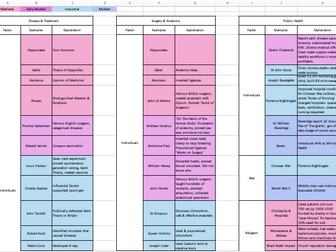History: Health & the People timeline
<p>Timeline of AQA History Paper 2 Section A/A: ‘Britain: Health and the people: c1000 to the present day’ course organised into three catagories, then by factor.</p>
<ul>
<li>The timeline is organised into three categories: ‘Disease & Treatment’, ‘Surgery & Anatomy’ and ‘Public Health’.</li>
<li>Within these catagories, examples are organised by factor: Individuals, War, Religeon, Chance, Government, Communication, Science & Technology, Economy</li>
<li>Examples for each factor are listed chronologically and colour coded by parts 1/2/3/4 in the textbook, followed by a short explanation, for example: Disease & Treatment | Individuals | Louis Pasteur | Swan neck experiment proved spontaneous generation wrong, Germ Theory, created vaccines</li>
</ul>
<p>Perfect for teachers teaching or students revising for History GCSE exam content. Very useful for question 4.</p>
<p>I have many other history resources on exam technique and other courses available in my shop which pair nicely with this.</p>
